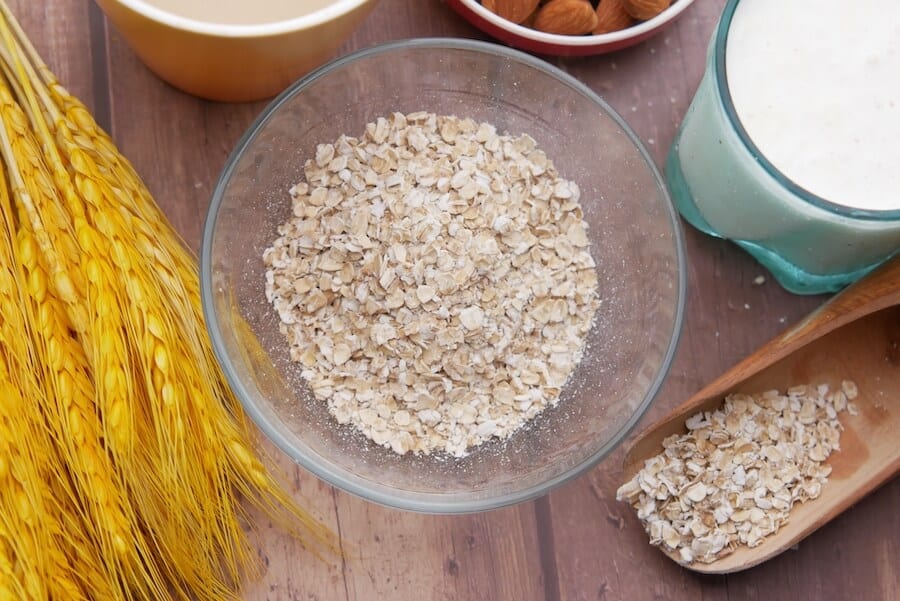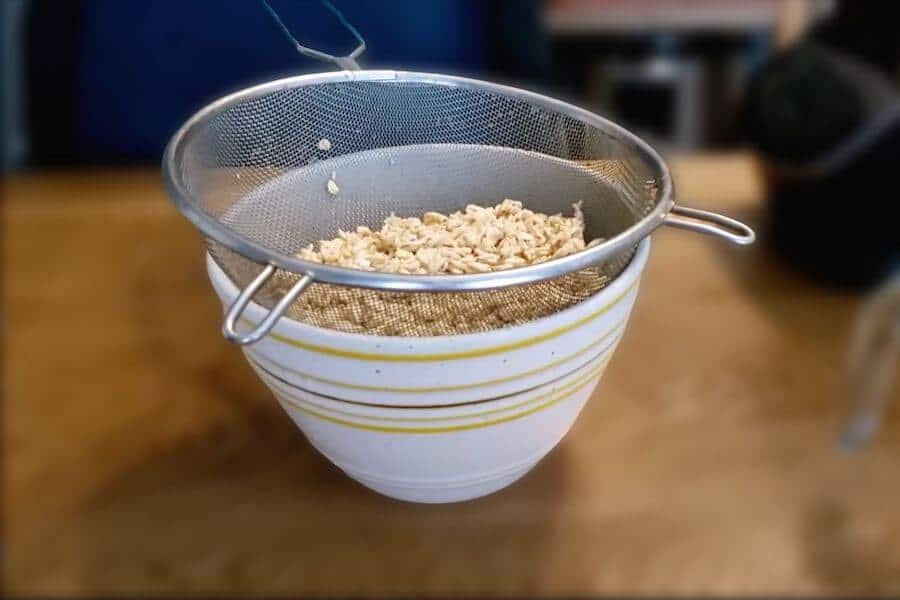Oat milk has grown in popularity as a dairy-free, nut-free, vegan-friendly alternative to cow’s milk. But what is oat milk made of, and how is it different from other plant-based milk?
Oat milk can be made from either oat groats (the whole grain seed with the husk removed), steel-cut oats (smaller pieces of oat groats), or rolled oats (steamed and flattened oat groats) that have been blended with water. It has a creamy, slightly sweet flavor and can be used in place of cow’s milk in many recipes. Oat milk is a good source of fiber and vitamins A and D and contains more protein than almond milk. It is also lower in calories than whole milk. Oat milk can be found in most grocery stores, online, or made from scratch at home.
This article will explore the ingredients and nutritional benefits of oat milk. Plus, we’ll provide tips on how to make your own oat milk at home!

What Is Oat Milk Made Of, And Where Does It Come From?
Oat milk is made by blending oats with fresh water and straining to remove any oat particles. It has a creamy, slightly sweet flavor and is a good alternative for those who are allergic to dairy or nuts.
Oat milk originates from Sweden, where it was developed in the early 1990s by a scientist named Rickard Oste, who was researching lactose intolerance and sustainable food.
Today, oat milk is available in many countries worldwide and is a popular choice for those looking for a non-dairy alternative. Though it is a straightforward recipe to make oat milk, manufacturers each have their own method. Some fortify the oat milk with additional vitamins and minerals, and some add stabilizers, emulsifiers, and flavoring.
Whether you’re looking for a new way to enjoy your morning oatmeal or want to add some creaminess to your coffee, oat milk is worth trying.

How Do You Make Oat Milk At Home?
Making oat milk at home is simple and requires only a few ingredients.
- Blend – Add the wet oats to a powerful blender with fresh, filtered water. Blend on high until the oats are broken down into a milk-like consistency (about 30-45 seconds). Don’t over-blend; this can make the texture slimy.
- Strain – Strain the oat milk through a cheesecloth, nut milk cloth, fine-mesh strainer, or t-shirt to remove any remaining oat pieces. Some oat milk may pool at the bottom of the strainer. Do not try to squeeze the pulp to get more liquid through the strainer. Doing this will make the milk slimy and gritty. Store the oat pulp for later use (get our favorite 13 things to do with oat pulp here) or discard it.
- Strain Again – This will help prevent the oat milk from becoming slimy.
- Chill – This step is optional, you can enjoy your oat milk immediately, but it should always be stored in the refrigerator. Homemade oat milk will last up to 5 days in the fridge or 2-6 months in the freezer (read more about freezing oat milk here).
That’s it! You can now enjoy your oat milk plain or use it in any recipe that calls for dairy milk.
What You Need To Make Oat Milk:
- Oats – We recommend rolled oats for the creamiest consistency
- Water
- Blender – use a strong one!
- Cheesecloth, nut milk cloth, or fine mesh strainer (you can also use a clean towel or t-shirt)
- Storage container that seals
How Does Oat Milk Taste?
Unlike other plant-based milk like almond or soy milk, oat milk is relatively creamy and rich, making it a good choice for coffee or baking.
However, some people find that oat milk can have a slightly “oaty” flavor that takes some getting used to. Many oat milk brands offer flavored options like sweetened, chocolate, or vanilla that many people enjoy. The unflavored option works well as an ingredient in sauces or a creaming vegan soup.
Are There Any Drawbacks To Using Oat Milk?
Many enjoy oat milk for its creamy texture and nutty flavor. However, there are also some potential drawbacks to consider. One is that oat milk is relatively high in carbohydrates, which could be a problem for people trying to watch their sugar intake.
In addition, oat milk is relatively high in calories compared to Almond milk, which might not be the best choice for people trying to lose weight. Also, oat milk does not contain as much protein as cow’s milk, so those looking for a protein-packed drink may want to choose something else.
Finally, oat milk can sometimes cause digestive issues like gas and bloating. However, these problems are usually only experienced by a small minority of people.
Overall, oat milk is a healthy and delicious alternative to cow’s milk that is worth trying if you’re looking for something new. Just be aware of its potential drawbacks before you make the switch.
Where Can I Buy Oat Milk?
Oat milk can be found in most grocery stores, health food stores, and online retailers (read more here). Some popular oat milk brands include Oatly, Califia Farms, and Silk. When shopping for oat milk, check the labels to ensure that it fits with any dietary restrictions you may have, like gluten intolerance. Though there is no wheat in oat milk, not all brands are gluten-free due to the machines used in the manufacturing process.
Recent Posts
Are you looking for an alternative to dairy milk? Or are you simply interested in what all the hype is about when it comes to oat milk? Look no further - we've got your questions answered! Oat milk...

